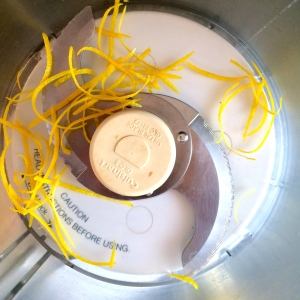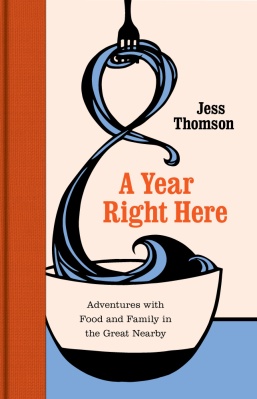You’ll hear, certainly from more dramatic writers, that working on a memoir is like childbirth: It’s painful. It takes too long. It shows you the part of yourself you never wanted to see. Technically, A Year Right Here—the series of essays flowering into form on my computer these days, in fits and starts—is not a memoir. But it is, in general, about me. And I find it is, in general, a more difficult process than writing cookbooks has been.
But for me, the process of writing a single essay is more akin to laying an egg. I can’t say why or when or how, but at certain times, my mind is capable of producing writing. When I feel the egg coming on, I find a nest—often Vif, the coffee shop in Seattle’s Fremont neighborhood whose breakfast menu typically refuels me late morning if I’m really on a roll—and I write. When the essay comes out, it’s almost fully formed, save some tinkering. It’s a matter of washing and perhaps scrubbing, but usually not one of constructing. But if there’s no egg, there’s no writing. If there’s no egg, I answer email or plan or pitch or simply walk away.
And so it happened that the other day, when I realized my cozy spot in the sun at Vif wasn’t going to be productive in any way, I gathered my dog and my mittens and my favorite orange bag and went for a walk in Discovery Park.
If you ask a park ranger, I’m sure she would tell you that picking foods out of Disco Park, as we call it, is strictly illegal. But as spring unfolds into summer and summer unfolds into fall, it’s not unusual to see folks picking things out of the undergrowth or off spiky blackberry bushes. And this year, the nettles are early. And on the whole, I do very few things that could land me in jail, so I figured picking was worth the risk.
Stinging nettles, as they’re so accurately named, are what I once called mint’s mafia cousin; they have spade-shaped leaves with toothy edges, but they’re corrupted by a taste for causing pain. Cooked and whirled up into, say, a pesto, the fine stinging hairs on the sunny side of each leaf learn to play nice, but if you touch them when the leaves are raw—i.e., when they’re still in the ground at Disco Park, or fresh out of the bag from the farmers’ market—they will cause paresthesia, which is a (temporary) numbing or stinging wherever the hairs contact your skin. I’ve learned, over the years, that it’s best to dump fresh nettles into a pot of boiling water, dirt and sticks and bugs and all. The less desirable stuff tends to float up to the surface, where it can be fished out with a slotted spoon, and I don’t get stung. But before this week, I’d never picked nettles myself.
It’s not hard. It took almost as much time to put on my mittens as it did to pluck a bag’s worth of nettles in a spot just out of view of the park’s walking trails—maybe five minutes, at the most. I simmered them until they were limp but still bright green, then buzzed them into a thick paste, along with strips of lemon zest, toasted walnuts, and olive oil. Yesterday, I smeared the nettle-walnut butter onto crackers and topped it with tinned sardines for lunch, and for dinner, I mixed it with olive oil and tossed it with pasta. Today, I’ll bring half of it in a small jar to the ladies at Tieton Farm and Creamery, who I’m visiting for the book. Maybe we’ll have it for breakfast, over eggs, with a smattering of fresh cheese.
First, though, I’m going back to the park, because it’s sunny and because there are nettles and because some days, there is just no egg.
Nettle-Walnut Spread (PDF)
This recipe calls for six ounces of fresh stinging nettles, but if you’ve dealt with nettles before, you know that measuring them—well, touching them in any way, really—is inconvenient, because the fine hairs on the sunny side of each leaf really do sting. Six ounces is about half a paper bag’s worth of unpacked nettles, if you’re picking them yourself.
Use the spread on sandwiches, smear it on a plate and top it with cooked eggs and crunchy sea salt, or dilute it a bit with water and dress a bowl of spaghetti (with additional chopped walnuts, toasted breadcrumbs, and freshly grated Parmesan, if you’re willing).
Makes about 2 cups
6 ounces fresh stinging nettles, stems and all
1 cup toasted walnuts
Stripped zest and juice of 1 medium lemon
1 teaspoon kosher salt (or to taste)
1/2 cup extra-virgin olive oil
Heat a large pot of water to a boil over high heat. Add the nettles without touching them, using tongs if necessary, and cook for 5 minutes, stirring occasionally, or until the nettles are all completely limp. Drain the nettles, spread on a baking sheet, and set aside until cool enough to touch.
Meanwhile add the walnuts, lemon zest and juice, and salt to the work bowl of a food processor. Using two hands, squeeze the nettles dry of any excess liquid a clump at a time, then loosen each clump before adding it to the food processor with the other ingredients. Pulse the nettle mixture until finely chopped, stopping to scrape down the sides of the work bowl every now and then. Add the olive oil, then whirl the mixture until smooth and thick. (It should looks like green hummus.) Season to taste with additional salt, if necessary.
Transfer the spread to an airtight container and refrigerate until ready to use, up to 2 weeks.




















































How Jewish tastes
Making matzo at home brings with it an unusual challenge: because the goal of eating matzo is to remember the sacrifices our forebears made, it’s not really supposed to be enjoyable. Store-bought matzo, if made appropriately, should leave one with the approximate sensation of having eaten crisp cardboard made out of dust. It’s shattery. It’s white. And it’s very, very plain.
The problem is, I usually avoid boxed matzo. I don’t steer clear because of the taste. I skip it because it’s just the type of white-flour product—plain, slightly sweet, and likely quite processed—that makes me feel crummy. Gluten-free matzo are commercially available, but they’re heinously expensive. And unlike regular boxed matzo, which often come in various flavors, gluten-free matzo are (in stores near me) always naked.
I lined up my matzo musts: First, I wanted my crackers to taste like an everything bagel, with a smattering of seeds. Second, I wanted to avoid grains, lest someone question my devotion to Ashkenazi Judaism (to which I am not even slightly devoted), practitioners of which typically avoid all grains during the holiday. Third, the matzo had to be disappointing in some way. There’s no point in making a cracker that doesn’t taste like suffering if you’re going to eat it for a week straight while pretending to suffer. I couldn’t call it matzo if it didn’t leave me needing a glass of wine, or at the very least, water.
“This can’t be called matzo,” said J, a high school friend who’s recently moved to Seattle. “It tastes too good.” She was munching on a cracker I’d made from a mixture of almond, coconut, and garbanzo bean flours—a mixture sprinkled with poppy, sesame, and caraway seed, crunchy sea salt, and dried onion flakes, then baked until the edges curled up. We dipped the crackers in hummus, pondered, and ate more.
“I’m no expert, but there is no way these are matzo,” she repeated. She was right. I wasn’t feeling even the least bit guilty about having a nice life, or peaceful surroundings, or leavened bread–not to mention making a cracker that took longer than the “official” limit of 18 minutes to make. I was feeling guilty about planning to not eat the same terrible cardboard everyone else planned on eating.
“They’re a cross between socca and a graham cracker,” declared Jim. And he was right. We actually enjoyed them.
The next day in the car, I started preparing Graham for what will probably be the first Passover dinner he will actually understand. I talked about how Jewish people take the holiday as a moment to slow down and appreciate what they have. About how we eat certain foods to celebrate the season, and how we always leave the door open, in part to welcome in anyone who might stop by with a hungry stomach.
“Mom, what does ‘Jewish’ mean?” he asked.
Right. I’d forgotten the basics. I’m a secular Jew: I’m Jewish by tradition and by generational duty, but not by proactive practice. We don’t talk very much about religion in our house.
“Jewish means something different to everyone,” I said carefully. I went on to give a very brief, very bad explanation of how religions differ, and how everyone needs to find out for themselves what practice works best for them, if any. Our conversation fizzled, and I cursed myself for being so unprepared.
Then, when we got home, I got an idea.
“Here,” I said. I handed him a matzo. “This is what Jewish tastes like to me.”
He refused to taste it. And in that moment—feeling guilty for giving the matzo too much flavor, and for failing to teach my son about my family’s past practices, and for realizing he had zero concept of what was going to happen later in the week at Passover dinner—I realized I could call it matzo. I’d suffered enough.
Eat it smeared with additional guilt.
Gluten-Free Everything Matzo Crackers (PDF)
Gluten-Free Everything Matzo Crackers
Made with a combination of garbanzo, almond, and coconut flours, these crackers have a texture slightly crisper than graham crackers, with a much more savory flavor. Topped with a smattering of the seeds you might find on an everything bagel—plus caraway, a favorite of mine—they make a good substitute for any cracker you’d use for hummus, cheese, or tuna salad. Put them on the Passover plate, if you feel like it—but be warned that they’re more flavorful than traditional matzo!
Look for minced dried onion in the spice section of your local grocery store.
Time: 35 minutes active time
Makes about 6 servings
2 teaspoons poppy seed
2 teaspoons white sesame seed
2 teaspoons dried caraway seed, roughly chopped
2 teaspoons minced dried onion
1 1/2 teaspoons crunchy sea salt, crushed til fine if large
1 cup (100 grams) potato starch
1/2 cup (60 grams) coconut flour
1/2 cup (50 grams) almond flour
1/2 cup (50 grams) garbanzo bean flour
1 teaspoon baking powder
1/2 teaspoon baking soda
Pinch kosher salt
1/4 cup extra-virgin olive oil, plus more for brushing
1/4 cup warm water
2 large eggs, blended
Preheat the oven to 450 degrees F, and space two racks evenly in the oven. Cut two pieces of parchment paper to fit the flat parts of two large (such as 12-by-17-inch) baking sheets. (You’ll roll the cracker dough out between the two pieces of parchment, so they need to be the same size. If you don’t have two baking sheets of the same size, just pick one, cut out two pieces of parchment to fit it, and bake the crackers in two batches.)
In a small bowl, blend the poppy, sesame, and caraway seed with the onion and sea salt with a spoon until well mixed. Set aside.
In the work bowl of a stand mixer fitted with the paddle attachment, stir together the potato starch, coconut flour, almond flour, garbanzo bean flour, baking soda, baking powder, and kosher salt just to blend. With the machine on low speed, add the oil, water, and egg. Increase speed to medium and blend for one minute, until crumbly. The mixture should clump together when you press a handful between your palm and fingers.
Pat the dough into a ball, then split it roughly in half. Place one of the parchment sheets on a clean work surface, then add half the dough. Top with the other sheet of parchment and roll the dough as thin as possible without breaking it; it should almost reach the edges of the parchment. (The goal is to make one giant cracker about the size of a baking sheet with each half of the dough.)
Brush one baking sheet with olive oil. Peel the top sheet of parchment off the rolled-out dough, then carefully invert the dough onto the prepared baking sheet, paper side up. Peel off the remaining piece of paper, and brush the dough with more olive oil.
Repeat the process with the remaining dough, using the same parchment paper. Scatter the spice mixture over both pieces of oiled dough, then pat the spices in with your hands so they stick. (If you’d like a more matzo-like look, use a fork or a rolling docking tool to poke small holes all over the dough.)
Bake the matzo for 5 minutes. Rotate the pans front to back and top to bottom, and bake another 5 to 7 minutes, or until the matzo is well browned on all edges and begins to curl up and off the pan. Transfer the crackers immediately to cooling racks and let cool for at least 30 minutes before breaking into pieces and serving.
Store any unused crackers in an airtight container, up to 3 days.
If you’ve followed the Uncle Josh Haggadah Project over the last five years, never fear, there is a 2015 edition. This year, it focuses on Montana, and was written in conjunction with our sister. Click here for the PDF of the 2015 Haggadah.
1 Comment
Filed under bread, commentary, Lunch, snack
Tagged as everything matzo, gluten-free matzo, homemade matzo, making your own matzo, passover, Uncle Josh Haggadah Project